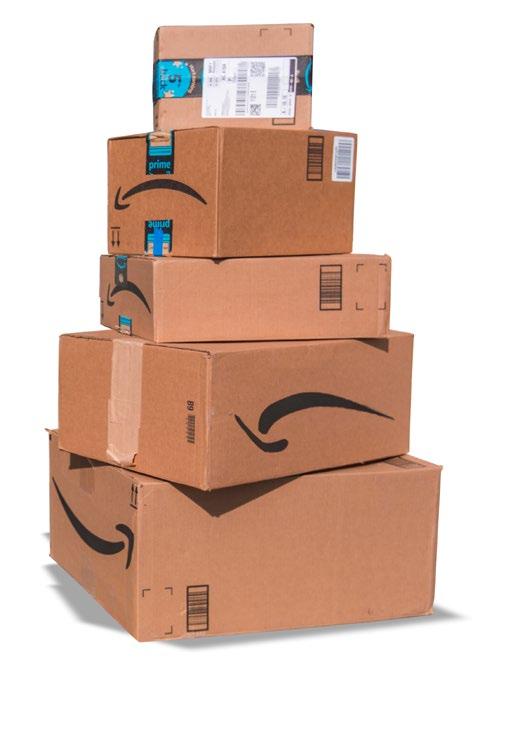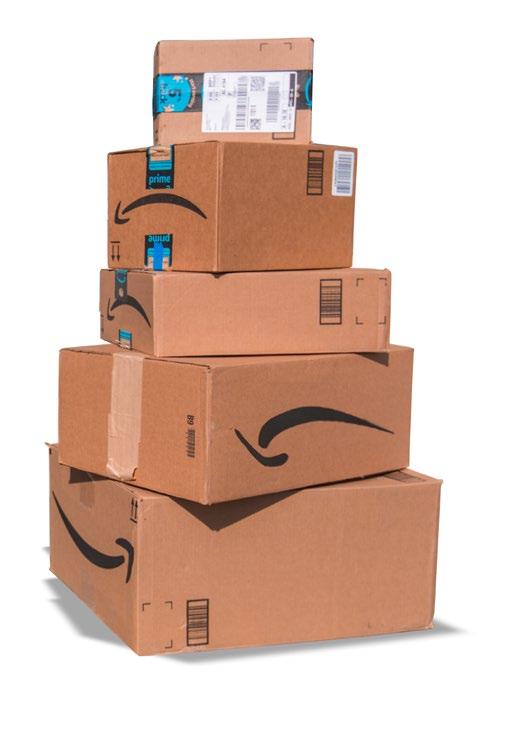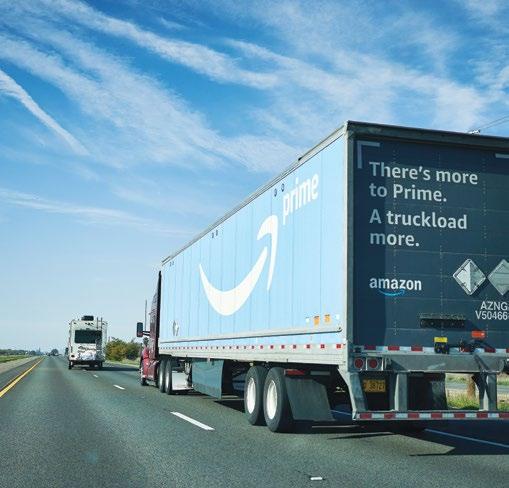
29 minute read
CULTURE
In Bezosworld
Amazon achieved its world-historical dominance thanks to failed policy and government
largesse. BY ALEXANDER SAMMON
B O O K S
Jeff Bezos is unique among his cohort of robber barons. Unlike Bill Gates, he is not Bezos? A Wall Streeter by trade, he moved into a house with a garage so he could claim to have really given to global-health, humanitarian, or philanthropic endeavors. He was one of the only American billionaires to resist signing the Giving Pledge, a soft commitment to give away half of one’s wealth that none of its signatories have gotten anywhere near to observing thus far. Mark Zuckerberg endowed a major American hospital; Andrew Carnegie founded a prestigious American college. No one is checking in at Bezos General or enrolling at Bezos U. His ex-wife has been aggressively generous with the family fortune post-separation; Bezos himself has not.
After Henry Ford handed off the presidency of Ford Motor Company, he began work on Fordlandia, his idealized society carved out of the Amazon rain forest, drawing on his development of Dearborn, Michigan. Bezos, at a similar age and endowment and recently “retired” from Amazon, has made no such commitment. He has extraterrestrial interests, but seemingly only by process of elimination. “The only way that I can see to deploy this much financial resource is by converting my Amazon winnings into space travel. That is basically it,” he said in 2018.
What motivates started Amazon in a garage. He chose Seattle, because Washington was small, and no sales out of state would be subject to sales tax. He sold books, not because he cared about literature, but because there were a lot of them. His mission was not to deliver Eden, but to create an empire. “Right a social wrong? Are you fucking kidding me? Jeff Bezos is a straight-up libertarian,” was how early Amazon investor Nick Hanauer put it.
Amazon is the world’s fourthmost-valuable company, which drastically understates the enormity of its operation. In 2005, when the company introduced Amazon Prime and free twoday shipping, it had just three American warehouses. Now, it is responsible for 50 percent of all e-commerce. Amazon has overhauled retail, cloud computing, groceries, logistics, entertainment, newspapers, pharmaceuticals, and even doorbells. It’s the second-largest private employer in the United States, and that doesn’t count its extreme reliance on subcontractors. According to one estimate, as many as 82 percent of U.S. households have Amazon Prime, and more people use it than voted for either major-party candidate in the most recent presidential election. Which is to say: Jeff didn’t need a patch of tropical rain forest to enact his vision for society. Bezosworld is a place on Earth, and we’re living in it.
Alec MacGillis takes full stock of what exactly that world looks like in his new book Fulfillment: Winning and Losing in One-Click America. Calling on a sweeping array of personal vignettes and tracing out lengthy historical through lines, MacGillis chronicles life across Amazonia through the eyes of drivers, pickers, sorters, corrugated-cardboard manufacturers, politicians, lobbyists, activists, artists, and more. Fulfillment also tells the story of how Bezos built Bezosworld. To understand Amazon is to understand trade policy, deindustrial-


CULTURE
ization, the collapse of unions, the demise of antitrust enforcement, the death of newspapers, campaign finance laws, the history of lobbying, real estate prices, regional inequality, and tax policy. Amazon, of course, is the Everything Store; is it not, too, the Everything Story? What part of America’s economy, its political climate, its empire in decline, or its spiritual injury doesn’t factor in? And if this chapter in our history is new, is it better?
Fulfillment begins with the pseudonymed Hector Torrez moving into a basement. Torrez once made $170,000 a year doing white-collar tech work. Now he makes $15 an hour at an Amazon warehouse, moving boxes in the dead of night, physically grueling work made worse by the coronavirus. Torrez has likely been exposed repeatedly, but the company has not made any effort to inform or protect workers.
Tales of downward mobility recur repeatedly in the book. Todd Swallows, whose father ran a reasonably remunerative trucking business in Ohio, spends a decade bouncing around at low-wage jobs before finally settling in as a temp at a plant making cardboard Amazon boxes, which pays just $10 an hour, the same rate he was getting as a 17-year-old at a pizza joint. Bill Bodani Jr., a retired union worker, works a forklift at a warehouse for $12 an hour, at the very same Baltimore site he once worked for Bethlehem Steel at $35 per. We know it’s true, because we know that wages, especially for people outside of the top 10 percent of earners, haven’t budged in 40 years, when they’re not going in reverse.
Worse, Jody Rhoads, who drives a pallet mover, gets accidentally killed in a Pennsylvania warehouse. She’s not the only worker whose story in the book ends in gruesome death. Repeatedly, Amazon does not inform fellow workers, or their families, of these outcomes. Sometimes regulators help the company craft a credible, exculpatory explanation.
First- and third-person accounts of Amazon’s warehouses of horrors have become books, magazines, podcast episodes, and more. MacGillis leaves unsaid that this was not Amazon’s invention. Warehousing was low-paid, grueling, and heavily reliant on temp workers before Amazon became shorthand for the entire industry. Workers at the Walmart warehouse cluster in Will County, Illinois, are no better or worse off than their counterparts at the Amazon cluster up the road. If the company has contributed any innovation to the sector, it’s the amount of technology it has committed to surveilling employees and minimizing their bathroom breaks.
In MacGillis’s telling, where it happens is as important as what happens. The small cities of Ohio and Pennsylvania thrived under the monopolistic giants of the industrial age, manufacturing steel and iron and the products they went into. These towns have not been passed over by Amazon. But the new jobs are terrible, worse than their previous employment at long-gone manufacturers and newer firms run out of town by the Amazon machine. Rural and exurban Virginia has received data centers, which consume a lot of energy but provide no jobs at all. And even if Amazon doesn’t show up, the corralling of third-party sellers onto its platform can savage the local economy from a distance. El Paso, far from the Rust Belt, has seen its office supply sector decimated, as small-business owners are forced to pay extortionate percentages of their sales to the company, if they can manage to get their prices low enough to beat Amazon’s own submarket rates. By 2018, Amazon’s cut of third-party sales made up a fifth of its revenue.
Meanwhile, places like Seattle, Manhattan, and Washington, D.C., don’t have to store the stuff. Instead, they get to house the programmers, lobbyists, and white-collar workers who make the real decisions—and the real money. Like its goods, Amazon funnels money out of forgotten places and into the gilded urban centers of choice, helping contribute to the stunning rise in real estate prices and the cost of living. Which means that people who thought they had nothing to do with the company, like Seattle artist Milo Duke, one of the book’s closest captures, are being chased out via soaring rents, in houses lapped up as investments by wellpaid white-collar workers.
The warehouse clusters have opioid addiction and pollution; the centers of capital get gentrification and platitudinous liberals. One area votes for Trump, the other for Biden. To tell all of that at once requires a wide scope, and sometimes the aperture does seem too wide (I’m not convinced that we need to know about the early career of David Rubenstein, who founded the Carlyle Group and then became president of the Economic Club of Washington, which eventually hosted Jeff Bezos for an event), but it allows us to see that this is indeed a closed loop. Amazon really is that big.
Amazon was hardly the only company to think up selling things over the internet—we could just as easily be talking about buy.com. What set Amazon apart was its merciless arbitraging of the American tax system, novel not in its conception but in its astonishing scale.
From the outset, the company refused to levy sales tax on almost all of its website orders, giving it an insurmountable pricing advantage over brick-and-mortar retailers. The company pushed this to extremes, putting warehouses just across the border of states that had the temerity to suggest it should pay taxes, and printing business cards for employees without the company name to obscure the workers’ presence. By the time America ditched the fanciful notion that sales tax evasion equals innovation, it was 2018, when the Supreme Court mercifully compelled e-retailers to collect taxes on in-state sales via a 5-4 decision. But at that point, physical retail was already deep into its well-catalogued apocalypse. And Amazon had spent over two decades draining astonishing resources from state and local governments, which in turn became less and less capable of regulating companies like Amazon.
If only that were all. Amazon double-, triple-, and quadruple-dipped in the public purse. It engorged itself
FULFILLMENT: WINNING AND LOSING IN ONECLICK AMERICA
BY ALEC MACGILLIS Farrar, Straus and Giroux

on massive government contracts, running huge data storage programs for the Pentagon and building websites to sell governments pencils and other basic items. When it came time to expand to fulfill promises like two-day shipping, Amazon demanded public subsidies for the new facilities, threatening implausibly to otherwise build them elsewhere. Soon, already enervated state and local governments were actively paying Amazon to build warehouses and data centers, situated right alongside the public roads and water pipes and power lines municipalities spend billions to create and maintain, where the company had to build and expand regardless. MacGillis chronicles these tax deals in excruciating detail. Governments arranged sundry property and payroll tax abatements, gave the company land for free, or kicked in straight-up cash. Amazon even created a secret internal target of $1 billion per year in local tax subsidies.
When a delivery route was prohibitively expensive, Amazon would simply let the publicly funded and price-controlled United States Postal Service handle it. And, of course, the federal government was already generously subsidizing the company’s rock-bottom wages. In Ohio, 1 in 10 Amazon employees is on food stamps; in at least five states, the company is one of the top employers of food-stamp recipients.
If Bezos had any particular ingenuity, it was in realizing that not only could Amazon avoid paying taxes to get a leg up over its competitors, but it could rely on witless local, state, and federal government representatives to actively grubstake the company’s growth. As a result, in 2018 Amazon contributed $0 in corporate tax on $11 billion in profit, and actually bagged a $129 million tax rebate. “[F]rom 2009 to 2018, the company paid an effective tax rate of 3 percent on profits totaling $26.5 billion,” writes MacGillis. Amazon wove a
A rally for Amazon warehouse workers attempting to unionize. In at least five states, Amazon is one of the top employers of food-stamp recipients.
new social fabric by threading an astonishing number of loopholes in the American tax system.
And the company took that money right back to the nation’s capital in the form of lobbying. “Between 2012 and 2017, Amazon’s spending on lobbying quintupled; by 2018, it had the largest lobbying office of any tech firm in Washington,” MacGillis notes. Bezos also bought up the city’s paper of record, The Washington Post, for $250 million, and didn’t meddle prominently in its affairs or offload its staff, securing him favorable status from the city’s press corps. It was an ingenious stroke of shadow lobbying, earning implicitly favorable treatment by flattering the fourth estate.
What becomes clear, finally, is that Amazon is a creation born of failure. Failed policy on trade, labor, and competition; failed ideas on the role of government in American society; a failed press corps that didn’t meet the moment with a sense of rightful opposition. A man who loves small government built a company on the bedrock of government largesse, and now it sits as a quasi-government, taxing every economic transaction for its own corporate treasury. There’s a temptation to believe that all these economic and social forces coincided to create this situation, but they did not. Bezos did this. And we, via our elected representatives at all levels of government, assisted him. We did it to ourselves.
Today, Amazon is a behemoth of such incomparable size that it can treat government as a subordinate rather than a rule-setter. When New York Attorney General Letitia James announced she’d been investigating workplace safety concerns at the company’s Staten Island warehouse, they sued her in a failed attempt to stop her from bringing charges, and asked the court to force her to declare that she does not have authority to regulate workplace safety. It was a stunning act of preemption, one that announced a new era of Amazon corporate citizenry, gnashing teeth behind the smiley face logo.
Amazon’s vision synced perfectly with the pandemic. As we stay at home watching caseloads and real estate prices soar, packages pile up on the doorstep and imperiled workers take more and more life-threatening risks. Do we like living like this? Is this definitely progress? Something is clearly amiss in American society, where lifespans are plummeting and the suicide rate inches ever higher. Maybe going to the store, talking to the checkout person, and paying sales tax wasn’t so bad.
What, then, can be done? Directing enough resources to aggressively enforce workplace safety standards would be a good start. A resurrection of organized labor would make a big difference, which is why Amazon has so fiercely opposed union drives. Some semblance of an antitrust regime would certainly go a long way. We could spin off Amazon Web Services, the company’s cloud computing arm that has become so profitable that it helped underwrite the rest of the business. (And gave it a deeply anticompetitive advantage. When companies come to AWS, Amazon knows they’re growing; if it’s a rival, Amazon can act accordingly.)
But with an empire built and sustained by public money, reliant on public infrastructure, and altogether imbricated in American life, it’s time to think seriously about one of the most forbidding words in American political discourse: nationalization. Amazon has worked hard to position itself as a public utility—think about how it has petitioned to facilitate the vaccine rollout. Why shouldn’t we treat it as we would any other?
Essential public infrastructure is very much the ambition Bezos had from the outset. That, presumably, and getting rich. With the latter entirely secured, it’s time for the rest of us to reclaim the giant we’ve unwittingly bred. n

MacGillis’s book demonstrates that Amazon is a creation born of policy failure.
Change Our Minds, Change the World
Two new books on the false narratives undermining
public policy BY ZEPHYR TEACHOUT
B O O K S
Imagination drives policy, and until we address deeply rooted yet flawed presumptions embedded in our political imaginations, we’re stuck with austerity, fragility, and inequality. That’s the core argument of two major books by Heather McGhee and Mariana Mazzucato.
McGhee and Mazzucato argue that two separate false constructs must be directly and explicitly addressed. For McGhee, it’s the belief that gains made by Black people must mean white people’s loss; for Mazzucato, the belief that government’s job is to reactively correct market failures, instead of being an exciting, creative force.
The books fit together like pieces of a puzzle. The failure to take bold public action with real investment in communities started in the 1970s, alongside an ongoing civil rights backlash. Together, McGhee and Mazzucato seek to overthrow both these frameworks, and offer a vision of an activist government with the drive to work to everyone’s betterment.
McGhee’s outstanding new book, The Sum of Us, argues that zero-sum thinking is behind decades of unnecessary suffering for all Americans, white, Black, and brown. While it may seem obvious how racism, and racialgroup competition, hurts Black Americans, she shows how it also hurts most white people.
McGhee, the former leader of the think tank Demos, peppers her deeply researched causal argument with intimate moments taken from three years traveling around the United States, talking to mostly white people who have been beaten up by America’s policy failures, and connecting their struggles to strategically deployed racial divisiveness.
The figurative device at the heart of The Sum of Us is a drained swimming pool. In the 1950s, parents who had spent their summers lounging around public swimming pools suddenly demanded that their cities and towns shut them down. Cement filled what had once been a center of joy and community and relaxation. Communities drained these pools to avoid integration, and went to court (and won) to defend their right to do so.
The swimming pool example reveals the first way racism hurts white voters. It leads them to oppose public programs when they have to share them with people of color, even if that leads to those beneficial programs shutting down.
A second effect of racial stereotyping and group identification is the zero-sum belief, which leads many white people to believe that they are harmed by anything that helps Black people. McGhee shares research showing that this does not work in the other direction; Black Americans do not assume that they are in competition with their white counterparts. She argues the zero-sum approach toward racial advancement has been a major driver behind our failures to fund higher education, address climate change, provide affordable housing, protect the right to vote, and provide health care to everyone.
A third effect is that white people—here McGhee highlights those in power—aren’t able to identify broken policies. The tendency is to ignore warning signs from communities of color, coding them as “their fault” instead of as a systemic failure. When the canary in the coal mine dies, they don’t treat it as an oxygen problem when the canary is Black.
For instance, 9.3 million homes were lost in the Great Recession, what McGhee calls the “far-reaching and permanent” impact of the “explosion on Wall Street.” This explosion led to metaphorical contagion—lowered home values, lowered
THE SUM OF US: WHAT RACISM COSTS EVERYONE AND HOW WE CAN PROSPER TOGETHER
BY HEATHER MCGHEE One World
MISSION ECONOMY: A MOONSHOT GUIDE TO CHANGING CAPITALISM
BY MARIANA MAZZUCATO HarperCollins
tax bases, weakened school funding and public services—and literal contagion, like demolitions of blighted properties that sent lead toxins into the atmosphere, as well as a rise in suicide, increased morbidity, and declining fertility.
There’s no question that homeowners of color were disproportionately impacted by the Great Recession, mainly because Black and Latino homeowners had more wealth attached to their homes. But in raw numbers, most foreclosed homes were white-owned. McGhee interviews some of the devastated victims. We feel we are sitting with her as she talks to Amy Rogers, a white woman who has gone from a homeowner with a city job to losing most of her belongings and working three jobs to make $24,000 a year, anxious about whether she’ll be able to pay rent.
The proximate cause of Amy Rogers’s precarity looks like a bad mortgage. The ultimate cause, McGhee argues, was a series of choices in the financial sector dating back to the 1840s, where racism and greed combined to create systems that exploited both people of color and white Americans. Clear warning signs of the Wall Street explosion were there by the early 2000s. The United States could have prevented the crash, McGhee says, if white decision-makers had translated abuses of Black homeowners as abuses instead of seeing them as something happening to the other.
In other words, racism cost Amy Rogers her house. White people should want to address racism not just because it hurts others, but because it is hurting them.
What is to be done? Racial identification and zero-sum thinking is a social fact. McGhee argues that, to erode it, lawmakers, organizers, and thought leaders must present an alternate framework. Research that McGhee commissioned when at Demos shows that a huge number of white Americans are more likely to support policies when race is explicitly addressed. They are more supportive of a policy that “puts the interest of working people first,” whether white, Black or brown” than

a policy that “puts the interests of working people first.”
McGhee is speaking directly to white people who don’t talk about race when they talk about policy, especially those who believe that emphasizing racial salience will increase zero-sum thinking, and make it harder to get more public investments. That’s a dangerous approach, she argues. Not talking about the racial impact of policies, when racism has been the defining feature of American political life for hundreds of years, has the impact of ceding the argument to the zero-sum crew. It also builds up false stories (see the infamous “welfare queen” trope) and leads to false explanations of current inequality, explanations that put the blame on those who are struggling.
There is a place for zero-sum thinking, of course, as McGhee demonstrates throughout the book. When it comes to competition between Wall Street or corporate monopolies and all Americans, the big guys really are taking a giant share of the pie at the expense of the rest of us. But unlike the zerosum thinking about race that dominates our current thinking, the Wall Street/monopolist concept is true. They benefit directly from racial division.
When, instead of silence, explicit connections between races are emphasized, it leads to what McGhee calls the “solidarity dividend.” It is a brilliant book, and its argument is liberatory. Truth-telling about race and the opponents of progress, and collectively building toward a community-based, multiracial future, doesn’t mean losing public-policy battles—it means gaining solidarity.
Ihave been a longtime admirer of Heather McGhee, ever since I got to work with her in 2009–2010,
The figurative device at the heart of The Sum of Us is a community swimming pool, drained to avoid integration.
when I was a new associate professor and she was the director of the Washington office at Demos, the think tank she later ran. She gave me guidance in D.C. etiquette and credit default swaps. During that time, we both attended an important event at the Roosevelt Institute called “Make Markets Be Markets,” with speakers including then-professor Elizabeth Warren and Joseph Stiglitz.
While economist Mariana Mazzucato would likely have agreed with many of the particular proposals put forward at the event, the title would have attracted her maximum ire, as her new book about political imagination, Mission Economy: A Moonshot Guide to Changing Capitalism, explains. The phrase “make markets be markets” presupposes a baseline functioning world of markets, which have the job to innovate, create, drive, and build. Subsequently, the job of government is to correct misfires in all of this generative activity, and then, only when absolutely necessary.
This market failure theory (MFT), Mazzucato argues, is wrong, dangerous, and getting in the way of a thriving economy. Government has been unfairly cast as an unimaginative, reactive partner or disciplinarian, constantly taming and filling in the gaps of the private sector, which may be potentially dangerous but is also the active, leading edge to which we owe all of our gratitude. In our current mental map, governments just “derisk and facilitate.” In reality, only the government has the capacity for radical transformation of our economy.
We must imagine government differently, and doing so requires us to also imagine markets differently. There is no such thing as the Platonic form of the market, which the government can bring about through tinkering and nudging. Instead, Mazzucato argues, there are things that need doing, and the government should do them, not just in the face of a “market failure,” but because they are valuable, important achievements.
Mazzucato’s figurative device is the trip to the moon, which takes on new life in her very able hands. She uses the Apollo program, where aeronautics, textiles, electronics, and medicine joined together in a grand mission that had extraordinary success and thousands of by-products, kick-starting technologies that are used throughout society today. This was not the government “regulating” moon travel, or “facilitating” it, but leading it, embracing the risk and uncertainty.
When we talk about public-private partnerships, we’re often in the world of Tim Geithner circa 2009, where big hedge funds are given a sweetheart, low-risk deal in exchange for helping out a little. But Mazzucato imagines aggressive project management on the government side, engaging private industries on an agile, as-needed basis.
What happened to the government that led that fight to the moon, she asks? Since Reagan and Thatcher, the state has been typecast as slow, bureaucratic, and reactive, and the private sector as fast, flexible, and creative. This typecasting shapes our bizarrely low expectations from the state. It’s as if we thought the role of cars was to make music instead of drive. Inasmuch as the market failure theory has a tinge of morality to it—you’ve heard the peculiar phrasing about what government should and shouldn’t do—it suggests that driving a car approaches the sinful. Why not drive the car? Why not go to the moon? Why not, in the last year, manufacture COVID-19 vaccines directly? Why spend all our time nudging markets when, in many cases, the state is better equipped, and state involvement will have enormous innovation benefits?
The MFT is not a single thesis, but a worldview that leads to a series of myths. Mazzucato punctures the idea that outsourcing improves effectiveness, or that government should be run like a business. These are all lazy theories that haven’t worked out in practice. Cost-benefit analysis, another mythically superior concept, treats policy questions as if they are scientifically answerable, instead of asking basic political questions like “What society do we want?”
Mazzucato is not interested in the government running all aspects of industry ad infinitum, but vigorously leading by ambitiously setting targets. The line between the two isn’t always clear. What’s also unclear is whether the kind of public-private partnership she envisions can work in the modern world, where the corporation is (as she knows) part of a massive, financialized web.
She is at her most persuasive with her impatience with our habits of fiddling around the margins, relying on corporate social responsibility to address massive problems that we have the power to take head-on. We must put government back in the driver’s seat, in fact and in our imaginations.
Mazzucato’s book brought to mind the big push at the beginning of the pandemic to get Donald Trump to use the Defense Production Act. Our political imagination was limited to demanding that the president use an existing law to nudge markets, instead of immediately calling on the government to produce masks, ventilators, and other key forms of equipment itself, to take on the mission of the moment.
The synergies between the two books are resonant. For example, the American public investments that Mazzucato holds up as models of public missions with big privatesector investments—from the mission to the moon to DARPA-backed funding that led to the internet—are examples of an investment where the imagined recipients and heroes were white.
But while they are both critiques, these are profoundly hopeful books.
If we can recast government as a creative, mission-driven force, if we identify the deep racial divisiveness underpinning austerity arguments, if we recast a booming multiracial society as an equal boon for all races, then the possibilities for a thriving economy and democracy open up, letting us imagine a country we have never yet seen. n Zephyr Teachout is a law professor at Fordham University and author of Corruption in America: From Benjamin Franklin’s Snuff Box to Citizens United and Break ’Em Up: Recovering Our Freedom From Big Ag, Big Tech, and Big Money.
Reconceiving the American Future
A new book argues that the vision of the United States as a ‘majorityminority’ society is a statistical illusion. BY CHRISTOPHER JENCKS
B O O K S
The idea that whites are inexorably becoming a minority in the United States has become a fixed assumption of American politics, celebrated by some on the left and feared by many on the right. But in this new book, the sociologist Richard Alba, a leading scholar of immigration and ethnicity, tells us that the prospect of America becoming a “majorityminority” society is a statistical illusion and the wrong way to think about how America is changing.
Responsibility for this perception, Alba argues, falls mainly on what he calls America’s “demographic data system,” which is controlled by the federal Office of Management and Budget. OMB’s rules require the Census Bureau to classify and count individuals by ethnicity and race in ways that magnify the apparent size of minority groups relative to whites.
In 2011, the Census Bureau reported on the basis of the OMB rules that a majority of babies born in the United States were members of minority groups. The next year, the Census Bureau made headlines by projecting that America would hit a crossover point in 2043, when non-Hispanic whites would fall below 50 percent of the population. As one might expect, many white Americans found these reports alarming.
These projections, Alba explains, overestimate the number of nonwhites for three reasons. First, when people report on official forms that they are both Hispanic (in answer to a question about ethnicity) and white (in answer to a question about race), the Census Bureau counts them as members of minority groups, not white. The media follow suit.
Second, since the 2000 census, people have been able to report more than one race, and most who do have reported being both white and some other race. These people, according to OMB’s rules, have been counted in the nonwhite category, so as not to diminish minority groups for purposes of judging discrimination. OMB made this decision at the behest of civil rights groups.
Counting all such people as nonwhite, however, departs from American social practices. Although American law in the late 1800s began following a “one-drop” rule in classifying people as Black, it has not followed that rule for Native Americans, Latinos, or other minorities. But census data now count those minority groups as though they were subject to a one-drop rule too.
Third, when a non-Hispanic white has a child with a member of some other racial or ethnic group, the census relies on the parents’ reports of their children, which usually respect both sides of the family. The census counts the children reported as mixed (and all of the child’s projected descendants) as nonwhite. This practice has enormous implications for population projections because of the surging number of Americans from mixed backgrounds. “By the 2050s,” Alba writes, “one of every three babies with white ancestry will also have Hispanic or racially nonwhite ancestry when second-generation mixes are counted.”
The trouble with the “majorityminority” narrative, in Alba’s view, is that many people whom the census is counting as minority belong to an increasingly diversified “mainstream.” During the 20th century, the white Anglo-Protestant mainstream diversified with the integration of Catholics and Jews. Today, Alba argues, the mainstream is diversifying again, with the integration of more-recent immigrants and their children, including the rising number from mixed marriages with non-Hispanic whites. Alba recognizes, however, that mixed Black-white Americans face more discrimination and tend to identify with the minority side of their background and that many Latinos face barriers because of their citizenship status. He sees whites as part of an enlarging mainstream, not a shrinking minority.
As a result, Alba wants us to stop using terms like “majority-minority” nation. His alternative is to revise the census and reconceptualize the mainstream as multicultural. This seems right.
Changing the census involves redesigning the two questions the census currently uses for ethnoracial classification. The first asks
about “Hispanic, Latino, or Spanish origin,” the second about “race.” Putting everyone who answers the first question in a minority group, even when they later say their “race” is white, puts immigrants from Spain (but not Portugal or Italy) in the “minority” category. Forcing everyone to choose their “race,” beginning with “white” and “Black,” focuses attention on color. Yet mainstream America is becoming ever more diverse, with people from other parts of the globe mixing, intermarrying,
THE GREAT DEMOGRAPHIC ILLUSION: MAJORITY, MINORITY, AND THE EXPANDING AMERICAN MAINSTREAM
BY RICHARD ALBA Princeton University Press

and living intermingled with “nonHispanic white” neighbors.
More specifically, Alba urges the Census Bureau to adopt a new version of the question about ethnoracial identity that the bureau tested successfully in 2015. That version would eliminate the first question on “Hispanic, Latino, or Spanish” origin and include that category with the other existing geographic/national ethnicities, such as “Chinese,” “Asian
Indian,” “Pakistani,” “Hmong,” and “Samoan” (now called “races”). It would make “Middle Eastern or North African” a separate group in this category, a move advocated by groups from those regions. Alba does not argue, but I take his suggestion to imply, that the census might then replace the color categories “White” and “Black” with “European” and “African,” and call them “ethnic,” “national,” and “geographic origins” rather than “races.”
Yet there are complications related to those who check off both white (or “European”) and another category. We could count them on both sides, keeping the white numbers high to counter the threatened-white narrative while also keeping the nonwhite numbers high to provide a baseline against which to judge the equity of government or other distributions. But if we do that, the total will add up to more than 100 percent. Although that decision seems defensible, it
would complicate record-keeping, making it unlikely to be adopted.
Another possibility would be for the census to do what Alba does himself: present a range of numbers based on different assumptions, instead of a single count or projection of America’s ethno-racial makeup.
Most of all, Alba wants to change the narrative about the future. He cites studies showing that when whites are told they will become a minority, they react with fear and anger and adopt more right-wing positions. The census, he says, should drop the binary between non-Hispanic whites and “minorities.” The data can tell a different story. Growing rates of intermarriage and increasingly diverse neighborhoods suggest the United States is accommodating demographic change. We need to ditch the old vision of assimilation in which immigrant groups become “white,” welcome a mainstream that looks different from the old one, and
rejoice in the diverse multicultural nation we are creating. n
Christopher Jencks is Malcolm Wiener Professor of Social Policy, Emeritus, at Harvard University and the author of such books as The Academic Revolution (with David Riesman), Inequality: Who Gets Ahead?, Rethinking Social Policy, and The Homeless. A longtime member of the board of The American Prospect, he has played a major role in the development of the magazine.







